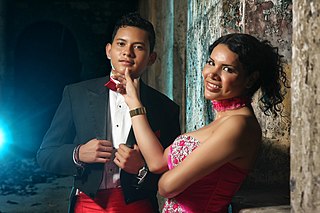
BDSM is a variety of often erotic practices or roleplaying involving bondage, discipline, dominance and submission, sadomasochism, and other related interpersonal dynamics. Given the wide range of practices, some of which may be engaged in by people who do not consider themselves to be practising BDSM, inclusion in the BDSM community or subculture often is said to depend on self-identification and shared experience.

Sexuality and gender identity-based cultures are subcultures and communities composed of people who have shared experiences, backgrounds, or interests due to common sexual or gender identities. Among the first to argue that members of sexual minorities can also constitute cultural minorities were Adolf Brand, Magnus Hirschfeld, and Leontine Sagan in Germany. These pioneers were later followed by the Mattachine Society and the Daughters of Bilitis in the United States.
Sissy, also sissy baby, sissy boy, sissy man, sissy pants, etc., is a pejorative term for a boy or man who does not demonstrate masculine traits, and shows possible signs of fragility. Generally, sissy implies a lack of courage, strength, athleticism, coordination, testosterone, male libido, and stoicism. A man might also be considered a sissy for being interested in typically feminine hobbies or employment, displaying effeminate behavior, being unathletic or being homosexual.

Butch and femme are masculine (butch) or feminine (femme) identities in the lesbian subculture which have associated traits, behaviors, styles, self-perception, and so on. This concept has been called a "way to organize sexual relationships and gender and sexual identity". Butch–femme culture is not the sole form of a lesbian dyadic system, as there are many women in butch–butch and femme–femme relationships.
Femme is a term traditionally used to describe a lesbian woman who exhibits a feminine identity or gender presentation. While commonly viewed as a lesbian term, alternate meanings of the word also exist with some non-lesbian individuals using the word, notably some gay men and bisexuals. Some non-binary and transgender individuals also identify as lesbians using this term.
LGBT slang, LGBT speak, queer slang, or gay slang is a set of English slang lexicon used predominantly among LGBTQ+ people. It has been used in various languages since the early 20th century as a means by which members of the LGBTQ+ community identify themselves and speak in code with brevity and speed to others. The acronym LGBT was popularized in the 1990s and stands for Lesbian, Gay, Bisexual, and Transgender. It may refer to anyone who is non-heterosexual or non-cisgender, instead of exclusively to people who are lesbian, gay, bisexual, or transgender. To recognize this inclusion, a popular variant, LGBTQ, adds the letter Q for those who identify as queer or are questioning their sexual or gender identity.
Effeminacy or male femininity is the embodiment of feminine traits in boys or men, particularly those considered untypical of men or masculinity. These traits include roles, stereotypes, behaviors, and appearances that are socially associated with girls and women. Throughout history, men considered effeminate have faced prejudice and discrimination. Gay men are often stereotyped as being effeminate, and vice versa. However, femininity, masculinity, and other forms of gender expression are independent of sexual orientation.
Lesbian, gay, bisexual, and transgender (LGBT) characters have been depicted in video games since the 1980s. Throughout the history of video games, LGBT characters have been almost nonexistent for a long time, reflecting the overall heteronormativity of the medium. While there has been a trend towards greater representation of LGBT people in video games, they are frequently identified as LGBT in secondary material, such as comics, rather than in the games themselves. Often, LGBT characters and themes, when they are included, are underrepresented, minimized, or watered down. Queer games and characters have also often found themselves being the subjects of cultural crossfires or moral panics. In 2018, Sam Greer of GamesRadar+ found only 179 games commercially released games with any LGBT representation, only 83 of which have queer characters who are playable characters, and only 8 of those games feature a main character who is pre-written as queer as opposed to them being queer as an option.

Jack Halberstam, also known as Judith Halberstam, is an American academic and author, best known for his book Female Masculinity (1998). His work focuses largely on feminism and queer and transgender identities in popular culture. Since 2017, Halberstam has been a professor in the department of English and Comparative Literature and the Institute for Research on Women, Gender, and Sexuality at Columbia University. Previously, he worked as both director and professor at The Center for Feminist Research at University of Southern California (USC). Halberstam was the associate professor in the Department of Literature at the University of California at San Diego before working at USC.
Boi is slang within butch and femme and gay male communities for several sexual or gender identities.

Sexual attraction to transgender people has been the subject of scientific study and social commentary. Psychologists have researched sexual attraction toward trans women, trans men, cross dressers, non-binary people, and a combination of these. Publications in the field of transgender studies have investigated the attraction transgender individuals can feel for each other. The people who feel this attraction to transgender people name their attraction in different ways.

LGBT themes in horror fiction refers to sexuality in horror fiction that can often focus on LGBTQ+ characters and themes within various forms of media. It may deal with characters who are coded as or who are openly LGBTQ+, or it may deal with themes or plots that are specific to gender and sexual minorities.

BDSM is a frequent theme in culture and media, including in books, films, television, music, magazines, public performances and online media.

Twink is gay slang for a man who is usually in his late teens to twenties whose traits may include a slim to average physique, a youthful appearance, little or no body hair, and flamboyancy. Twink is used both as a neutral descriptor, which can be compared with bear, and as a pejorative.
LGBT linguistics is the study of language as used by members of LGBT communities. Related or synonymous terms include lavender linguistics, advanced by William Leap in the 1990s, which "encompass[es] a wide range of everyday language practices" in LGBT communities, and queer linguistics, which refers to the linguistic analysis concerning the effect of heteronormativity on expressing sexual identity through language. The former term derives from the longtime association of the color lavender with LGBT communities. "Language", in this context, may refer to any aspect of spoken or written linguistic practices, including speech patterns and pronunciation, use of certain vocabulary, and, in a few cases, an elaborate alternative lexicon such as Polari.

Transmisogyny, otherwise known as trans-misogyny and transphobic misogyny, is the intersection of transphobia and misogyny as experienced by trans women and transfeminine people. The term was coined by Julia Serano in her 2007 book Whipping Girl to describe a particular form of oppression experienced by trans women. In an interview with The New York Times, Serano explores the roots of transmisogyny as a critique of feminine gender expressions which are "ridiculed in comparison to masculine interests and gender expression."

The following outline offers an overview and guide to LGBT topics.

Femboy, also spelled femboi, is a slang term for a male or non-binary individual who expresses themselves with traditionally feminine behaviours. As an internet aesthetic, this may be through the use of jewellery, wearing feminine clothing and makeup, or expressing feminine behavioural qualities. Femboy can be used as both a sexual and non-sexual term; it does not denote a specific sexual orientation or gender role but instead marks a form of gender variance.
Les is a derogatory local Vietnamese term of identification for more globally common labels like lesbian, queer woman, or female homosexual. It is derived mainly from scholarship by Vietnamese-American ethnographer Natalie Newton, who is, at present, the only Western scholar to have centred Vietnam's les as her subject of investigation. Her articles have been frequently cited as reference or point of entry to issues concerning Vietnamese queer communities.
Vakasalewalewa are people from Fiji, who were assigned male at birth but who have a feminine gender expression. In Fiji this is understood as a traditional third gender identity, culturally specific to the country.











